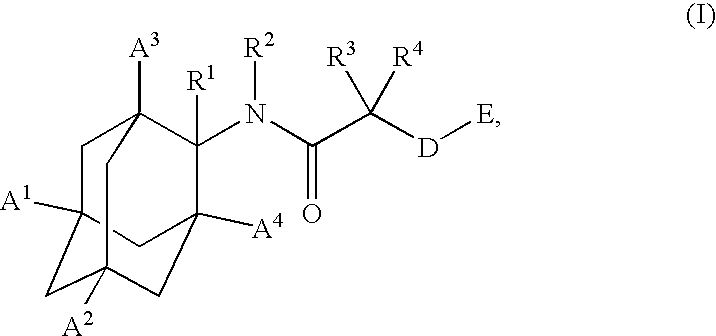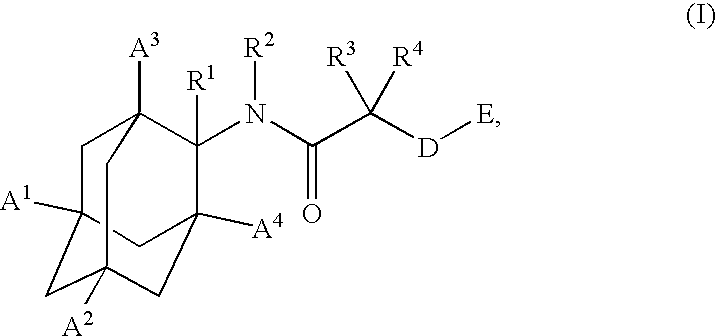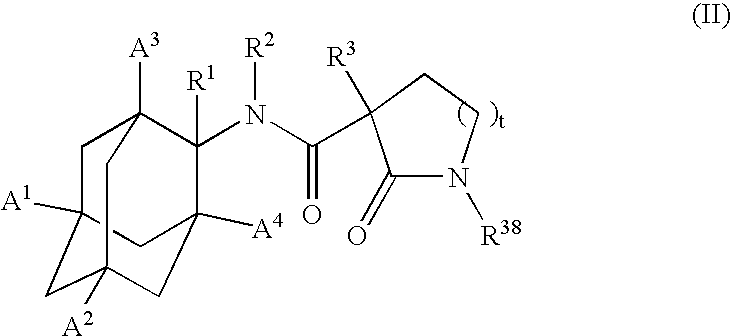Inhibitors of the 11-beta-hydroxysteroid dehydrogenase type 1 enzyme
a technology of hydroxysteroid dehydrogenase and enzyme, which is applied in the direction of anthracene dye, drug composition, metabolic disorder, etc., can solve the problems of increased and premature morbidity and mortality, poor compliance, and insufficient compensatory increase to overcome insulin resistan
- Summary
- Abstract
- Description
- Claims
- Application Information
AI Technical Summary
Benefits of technology
Problems solved by technology
Method used
Image
Examples
example 1
E-4-{[1-(4-Chloro-phenyl)-cyclobutanecarbonyl]-amino}-adamantane-1-carboxylic acid
example 1a
4-oxo-adamantane-1-carboxylic acid
[0484] A 5 L 4-neck flask equipped with N2 inlet / bubbler with H2O trap, overhead stirring, and an addition funnel was charged with 30% oleum (˜10.5 volumes, 2.2 L, 8×500 g bottles+100 mL), and heated to 50° C. under a slight N2 flow. 5-Hydroxy-2-adamantanone (220 g, 81 wt % purity, 1.07 mol) was dissolved in 5 volumes HCO2H (˜98%, 1.10 L) and added drop-wise to the warm oleum solution over 5 hours. The addition rate was adjusted to maintain the internal temperature between 70-90° C. After stirring an additional 2 hours at 70° C. The reaction solution was cooled to 10° C. in an ice bath. 20 volumes of 10% NaCl aq (4 L) were cooled to 2Cl2 (3×2.2 L) and the combined CH2Cl2 layers were then washed 1×2 volumes with 10% NaCl (1 L). The CH2Cl2 solution was then extracted 3×5 volumes with 10% Na2CO3 (3×2.2 L). The combined Na2CO3 extracts were washed with 1×2 volumes with CH2Cl2 (1 L). The Na2CO3 layer was then adjusted to pH 1-2 with concentrated HCl (˜2...
example 1b
E- and Z-4-amino-adamantane-1-carboxylic acid
[0485] To 1.0 g (10 wt %) of 5% Pd / C is added 10.0 g of the product from Example 1A followed by 200 mL (20 volumes) of 7M NH3 in MeOH. The reaction mixture is stirred under an atmosphere of H2 at RT for 16-24 hours. 200 mL of water is added and the catalyst is removed by filtration. The catalyst is washed with MeOH. Solvent is removed by distillation at a bath temperature of 35° C. until solvent stops coming over. Approximately 150 mL of a slurry remains. 300 mL of MeCN is added to the slurry, which is then stirred for three hours at RT. The slurry is filtered and washed once with 100 mL MeCN. The wet cake is dried at 50° C. and 20 mm Hg under N2 to afford the title compound with a 13.1:1.0 E:Z ratio by 1H-NMR (D2O).
PUM
| Property | Measurement | Unit |
|---|---|---|
| Rg | aaaaa | aaaaa |
| Rg | aaaaa | aaaaa |
| Rg | aaaaa | aaaaa |
Abstract
Description
Claims
Application Information
 Login to View More
Login to View More - R&D
- Intellectual Property
- Life Sciences
- Materials
- Tech Scout
- Unparalleled Data Quality
- Higher Quality Content
- 60% Fewer Hallucinations
Browse by: Latest US Patents, China's latest patents, Technical Efficacy Thesaurus, Application Domain, Technology Topic, Popular Technical Reports.
© 2025 PatSnap. All rights reserved.Legal|Privacy policy|Modern Slavery Act Transparency Statement|Sitemap|About US| Contact US: help@patsnap.com



